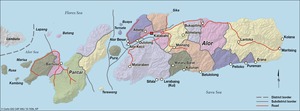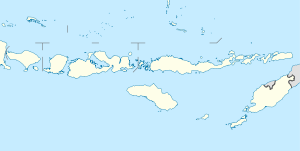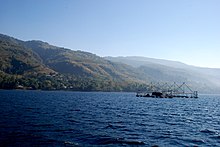Alor
| Alor | ||
|---|---|---|
| Administrative units on Alor and Pantar | ||
| Waters | Lake Flores , Lake Sawu | |
| Archipelago | Alor Archipelago , Lesser Sunda Islands | |
| Geographical location | 8 ° 15 ′ S , 124 ° 45 ′ E | |
|
|
||
| length | 90.4 km | |
| width | 35.1 km | |
| surface | 2104.76 km² | |
| Highest elevation | Gunung Muna 1839 m |
|
| Residents | 145.299 (2010) | |
| main place | Kalabahi | |
| Map of Nusa Tenggara Timur with Alor in the north | ||
Alor ( Ombai, Malua ) is with 2104.76 km² the largest island of the Indonesian Alor archipelago and part of the Lesser Sunda Islands .
geography
The island is part of the administrative district ( Kabupaten ) Alor , which is formed from the entire Alor archipelago. It belongs to the Indonesian province of East Nusa Tenggara . The capital of the administrative district is Kalabahi , the only city on Alor. With around 60,000 inhabitants, it is also the economic center of the archipelago.
To the east of Alor are the islands of Wetar and the East Timorese Atauro , to the south is Timor . Alor is separated from these islands by the Strait of Ombai . To the north, across the Floresee , are the Tukangbesi Islands . To the west, across the Pantar Strait , lies the island of Pantar .
Alor, like the other islands in the Inner Banda Arch , is of volcanic origin and very rugged. The highest mountains are the Kolana ( 1765 m ) and the Muna ( 1440 m ). The region around Kalabahi is the only flat area. This is one of the reasons why the Dutch colonial rulers moved the island's capital and main port from Klein-Alor ( Alor-Kecil ) to Kalabahi in 1911.
Residents
At least 14 different native languages are spoken in the Alor Archipelago. Some estimates even assume 50 languages. Except for the two Austronesian languages Bahasa Alor (Aloresian, Bahasa Lamaholot) and Kalabahi Malay , all other languages on the island are Papuan languages , in other sources non-Austronesian languages are mentioned. All of these languages are threatened, some have fewer than 500 living speakers, and many children are no longer learning the local languages. Bahasa Alor is spoken only in a few fishing villages, as well as on some other islands in the archipelago. It is related to languages from the east of Flores . Bahasa Indonesia , the official language, is increasingly being taught as the first language.
history
Five fishhooks were found under the chin and jaw of a woman in a tomb on Alor, dated to an age of 12,000 years. The Pleistocene hooks are made from the shell of a sea snail. Although older hooks are known from East Timor , Japan and Europe , this is the oldest find of grave fish hooks.
The Portuguese were the first Europeans in the region in the 16th century. At that time, Alor was considered the home of cannibals who did not want to be converted to Catholic Christianity. Only later did Calvinists succeed in converting part of the population. In the past, Islam was able to establish itself in parts of the island. A Koran from the 12th century is kept in Groß-Alor (Alor Besar), which was brought here by five missionaries around 1500 from the Moluccan island of Ternate . Iang Gogo , one of these brothers, is said to have married Princess Bui Haki of Bunga Bali (on Pantar) and settled in Greater Alor, while his brothers settled in Tuabang , Baranusa (both on Pantar), on Solor and in Kuilerabaing (southwest Alor ) settled. Iang Gogo's descendants are said to have settled in Klein-Alor (Alor Kecil), Aimoli , Alila , Ampera , Dulolong and other villages. The Portuguese rarely visited the smaller islands around Timor, but officially claimed suzerainty. Beeswax, slaves and turtle shells served as trade goods.
In 1851 the Portuguese governor José Joaquim Lopes de Lima sold Portugal's claims to the Alor Archipelago and other areas of the Lesser Sunda Islands, nominally under Portuguese sovereignty, to the Netherlands for 200,000 florins without authorization from Lisbon . Lopes de Lima fell from grace and was deposed and arrested when Lisbon learned of the treaty. On the return trip to Portugal he died in Batavia . From 1854 the agreements were renegotiated. The sale was finally confirmed in the Lisbon Treaty . The ratification took place in 1859. However, the old connections between Alor and the Portuguese Timor persisted for a long time . In 1886 the Alor locals paid an annual tribute to the liurai of Liquiçá in the form of rice, corn, cotton and other things.
economy
The infrastructure is poorly developed. Agriculture for self-sufficiency still dominates the picture. The government is trying to change this with the help of international organizations. Vanilla is grown in the village of Apui . In addition, tamarind , almonds and other nuts planted. Sandalwood is extracted in the forests .
Recent research has discovered natural resources such as gypsum , kaolin , petroleum and natural gas , tin , gold and diamonds . Black pebbles have been exported from the archipelago as a decorative medium since 1980.
The Alor Archipelago has some of the best snorkeling and diving areas in Indonesia. However, there are strong currents here, which make it advisable to only dive with someone who is familiar with the area. However, the advent of excessive fishing has destroyed some coral reefs .
The IATA airport code for Alor Airport is ARD . It is ten kilometers from Kalabahi. During the dry season , Kalabahi is served five times a week from Kupang , the provincial capital, from a Kasa operated by Merpati Airlines . Since mid-2003, a route Kupang Kalabahi- is Kisar - Ambon offered with return flight the next day.
Ferries run weekly from Kupang ( West Timor ) to Kalabahi. The journey takes 20 hours. Twice a week a ferry runs the route Larantuka ( East Flores ) - Lewoleba ( Lembata ) - Baranusa (Pantar) - Kalabahi in 20 hours. Once a week there is a ferry from Atapupu (West Timor) to Kalabahi in nine hours. In addition, the Pelni passenger ships Serimau and Awu call at Kalabahi every week. Due to the strong winds and large waves, the connection to Alor is often interrupted during the rainy season .
Freighters mostly go from Alor to Surabaya , Makassar and the Moluccas . The main port of Alors has a capacity of 600 gross tons.
In Kalabahi, shared taxis ( bemos ) provide public transport. Buses go to other places on Alor, jeeps, so-called pansars , to the mountainous interior of the island . Small boats connect towns and neighboring islands via the waterway.
Culture
Above all on Alor and Pantar there are depictions of Nagas , mythical serpent creatures , as protection on the traditional communal houses ( Adat houses). The old belief in these spirit beings was pushed back more and more. At the beginning of the 20th century, Christian missionaries burned all the snake-like wooden figures that were not hidden by the population in time. On the island of Alor, the wooden nagas with a sacred stone at their feet were placed in the central village square ( fairground ) and were called ulenai . Since the Lego lego dance was also banned, the traditional funeral ceremonies could no longer take place properly, which meant that the ancestors from the afterlife were just as unable to intervene as the missing Nagas and the population did not know how they felt before the influence who was supposed to protect foreign Nagas.
Web links
Individual evidence
- ↑ HASIL DAN PEMBAHASAN
- ↑ a b c d Regional Government of Alor: General Information ( Memento of February 10, 2005 in the Internet Archive )
- ^ Britannica
- ↑ Ethnologue report for language code: aol
- ↑ Sue O'Connor, Mahirta, Sofía C. Samper Carro, Stuart Hawkins, Shimona Kealy, Julien Louys, Rachel Wood. Fishing in life and death: Pleistocene fish-hooks from a burial context on Alor Island, Indonesia. Antiquity, 2017; 91 (360): 1451 DOI: 10.15184 / aqy.2017.186
- ↑ Jakarta Post: In Alor, a centuries-old Koran is revered, June 13, 2012 , accessed July 28, 2013
- ↑ a b History of Timor (PDF file; 805 kB) - Technical University of Lisbon
- ^ Regional Government of Alor: Commodities ( Memento of February 10, 2005 in the Internet Archive )
- ↑ a b c Regional Government of Alor: Transport to - and from Alor ( Memento of December 27, 2004 in the Internet Archive )
- ^ Regional Government of Alor: Transport on Alor ( Memento of December 27, 2004 in the Internet Archive )
- ↑ Susanne Rodemeier: From snake dragons and Rankennagas. Museum of World Cultures, Frankfurt 2008






